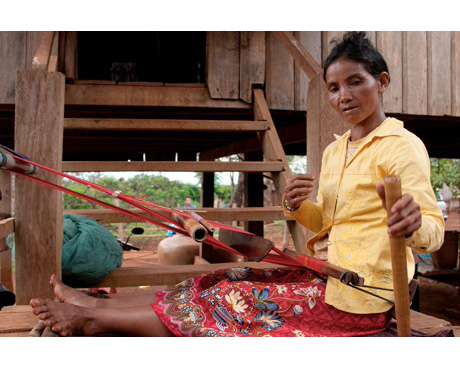

Cutting-edge business tools revamp age-old Cambodian tradition

Handicraft weaving, a tradition passed down through generations of indigenous peoples in Cambodia, is being updated through an MDG-F-funded programme to improve life for the country’s poorest inhabitants.
Since 2009, 800 indigenous people across four Cambodian provinces have begun learning new entrepreneurial skills — including marketing and quality control, exhibition, costing and consignment techniques — to sell more textiles and products and increase their families’ incomes.
Planh Proleav, a 27-year-old woman from the Kroeung indigenous group in the northeastern province of Ratanakiri, found that her new skills have been a boon for her business. “We are happy that more people are interested in buying our products. We are able to earn more money for food, medicine and books for our children to study. Before, we hardly made any income,” said Planh , one of 195 people who received training in her village. Like many indigenous and rural Cambodians, Planh uses handicrafts to supplement the income her family earns from farming, which is usually insufficient.
The initiative is part of the Creative Industries Support Programme (CISP), a partnership between UN agencies and local organizations that supports indigenous and Khmer artisans in northern and eastern Cambodia.
In Ratanakiri, where Planh Proleav lives, sales of indigenous-weaved products increased by 18 percent between October 2010 and March 2011 compared to the same six-month period in 2009, according to the civil society group Cambodian Non-Timber Forest Product Development Organization (CANDO), which is providing training and helping the artisans to find markets for their handicrafts.
“In the past they didn’t understand the market, but through the training they know how to set their product prices to factor in the cost of raw materials, labour and production tools,” said CANDO staff member Heng Socheath.
Villagers like Proleav weave textiles and sell them to CANDO, which sub-contracts other producers—mostly women and people with disabilities—to turn them into finished products. Notebook and laptop covers, shopping bags and wallets made from the woven textiles are sold at tourist outlets in the capital, Phnom Penh, including a shop established with the support of the joint UN programme.
Indigenous people are the poorest of Cambodia’s poor, living in remote, inaccessible parts of the country and suffering from multiple disadvantages, including poor health, lack of education and food insecurity. Almost one in four children in Ratanakiri die before reaching the age of five, and three quarters of the population is illiterate.
Programmes like the CISP, that empower the most marginalized people to increase their own livelihoods, are a key to the MDG-Fund’s work in helping countries achieve the anti-poverty Millennium Development Goals equitably. A particular focus of MDG-Funded programmes is to improve life for poor women, who remain among the world’s most disadvantaged citizens.
The CISP programme has given women like Planh Proleav greater independence from their spouses. “Unlike in the past where they depended on their husbands to provide for them, many of them are now able to make money for their families,” said Heang Sarim, president of CANDO.
In addition to improving indigenous peoples’ incomes, the CISP programme also helps preserve the cultural heritage of several Cambodian ethnic groups, under threat as the young generation increasingly migrates toward the national and global culture of clothing, entertainment and language.
“Many indigenous communities have already abandoned their weaving tradition,” said Sarim. “They couldn’t find markets to sell their products and didn’t have support to improve product quality.”
***********************************************************************************************
The Creative Industries Support Programme (CISP) is funded by the MDG Achievement Fund and implemented by FAO, ILO, UNDP and UNESCO in partnership with the Cambodian government and local organizations.
Its aim is to revive Cambodia’s cultural assets and create jobs, spur economic growth and reduce poverty by developing the country’s creative industries.